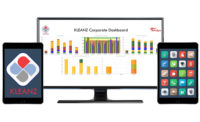New technology improves traceability solutions in food manufacturing
Snack and bakery companies today need to track incoming ingredients from production, to finished product, to sale

Traceability is essential in the snack and baking industry. Ingredients always need to be tracked, and this is especially important in the case of a recall. These days, implementing a comprehensive software suite is often an essential step in establishing a strong food safety program.
Advancing technology
“When it comes to traceability, distributed ledger technology, or ‘blockchain,’ is often the first thing that comes to mind for the modern food producer,” says Pratik Soni, founder and CEO, Omnichain Solutions, Los Angeles. Many are keen to implement the technology, as it provides a decentralized, digital record of every step in a product’s lifecycle—from raw ingredients, through production, to distribution to the retail shelf and in the consumer’s hands, he says. “Once logged on the ledger, the data are immutable and shared with everyone across the supply chain, ensuring full traceability, transparency, and accountability.”
Some companies may think that blockchain for the food supply chain is still something in its infancy, but there are very mature solutions available today, explains Soni. “Namely, blockchain-as-a-service (BaaS) platforms, like the one offered by Omnichain, are available now, that enable manufacturers to go fully live and functional with their own distributed ledger—connecting the many disparate systems, records and databases across their supply chain—through simply an internet browser in under 90 days,” he notes.
Since users only need an internet browser to connect to the network, BaaS platforms can scale along with a business as it grows, says Soni. “A monthly subscription-based payment model also makes deployment affordable so that small to mid-sized food brands can reap the same traceability benefits as a large corporation. In today’s society, where consumers now demand more information about the goods that they purchase, definitive insight into product provenance can be a powerful differentiator.”
Traceability software should be a standard in any ERP package that deals with the food and beverage industry, says Erin Schlee, marketing communications manager, SYSPRO USA, Costa Mesa, CA. “SYSPRO Software has had lot traceability built into the core of the system for years, enabling companies to track ingredients from raw materials all the way through to finished product.”
Christine C. Akselsen, CEO, Kezzler, Oslo, Norway, says that Kezzler has recently enhanced its platform’s traceability capabilities. “While previously focused on enabling product authentication and production control, we have now moved to integrate our platform deeper into the complete lifecycle of products.” This includes deeper integration of the platform into supply-chain systems, enhancing track-and-trace functionalities, and support for global interoperable product identification standards like GS1’s Digital Link, she says.
This interoperability and capability of integration lends support for global traceability initiatives, such as Russia's “cryptocode” serialization mandate (Federal Law No. 488-FZ), which becomes effective this January—and which will extend to almost all product areas, notes Akselsen.
Further regulation around food safety has moved manufacturers toward much more detailed lot tracking and traceability, says Wayne Ortner, senior product consultant, FlexiBake, Vancouver, British Columbia. “ERP and WMS like FlexiBake have needed to adapt to keep up with the new regulations and trends. FlexiBake’s warehouse management system has detailed lot tracking on both ingredients and on packaging, palletization by lot numbers, intelligent placement of finished goods, and detailed raw material picklists generated from a live inventory.”
One of the major barriers FlexiBake has seen when it comes to the idea of scanning lot numbers into inventory is that most major suppliers will supply product with lot numbers on their ingredient packages, but barcoded lot numbers are not yet included, meaning there is no way to scan lot codes into any system, Ortner adds. “The only way to integrate lot code scanning into an automated production floor is to manually write input the lot number, create the barcode and label, and then stick it on the ingredient yourself. Once suppliers include scannable lot numbers on barcodes, it will make integrating scanning devices much more attainable for manufacturers.”
Elemica, Wayne, PA, has a new quality solution that integrates and simplifies multiple challenging facets of today’s supply chain, says Kurt Nusbaum, VP, quality management solutions. “Ranging from multitier traceability through raw material product quality and supplier nonconformance management, this new solution provides integrated visibility previously not available to manufacturers and distributors.”
Streamlining communication among suppliers, customers, and manufacturing sites creates an inter-enterprise traceability, quality, and compliance solution that minimizes costly product quality and delivery issues, notes Nusbaum. “Extending supply chain data gives manufacturers and participants the upstream visibility and control they need to provide improved downstream customer service. Elemica offers an end-to-end digital supply network that not only provides traceability well beyond first-tier suppliers and throughout the manufacturing process, but also captures quality data in the form of an electronic certificate of analysis (e-COA).”
By linking supplier COA data with shipment information, you not only gain traceability, but you also receive real-time alerts to risky material variation within the supply chain, Nusbaum adds. Elemica’s traceability and quality management solution also provides supplier nonconformance and regulatory tracking and automation, he says. “The combination of visibility, traceability, and transparency into supply chain processes means you gain molecular insights into what is happening within your supply chain, from raw materials to end customers. This includes all documentation, transaction, data exchange, messaging, etc.—all shared on a networked platform so that all trading partners have accountability and understand escalation paths, if needed.”
The deep knowledge and insights gained from information within the supply chain, along with quality information shared on COAs, means that risk can be minimized, saving costs and improving customer satisfaction, he explains.
Forward thinking
Matt Brown, CEO, Wherefour, Petaluma, CA, says that they’ve been impressed with the ruggedized tablet and phone-sized products that Zebra Technologies has introduced. “These are laser scanners with highly accurate scanning capability. Zebra has 8- and 10-inch Android tablets with built-in laser barcode scanners. They are a convenient and easy-to-hold size with a catcher’s mitt style grip.”
The tablets are ruggedized to work in cold and wet environments, which is common in many food applications, Brown notes. “Having a built-in laser barcode scanner is a big feature, because laser scanning is more accurate than phone or tablet cameras. Wherefour recently announced a partnership to integrate its traceability and ERP software with Zebra devices. This means a user can have everything they need in one tablet.”
Ortner says that he’s seen a major shift in the hardware that’s being used to run today’s food manufacturing software. “Historically, manufacturers would opt for an industry-specific or manufacturing-specific device to run their software. Today, more and more companies are using smartphones, tablets, and mobile printers that are not necessarily designed for the food manufacturing industry.”
Technology is also growing more predictive. Schlee says that RFID software and handheld scanners are standard products, but AI and machine learning can assist with this in the sense of contamination and allergies. “For example, with allergies, you might use artificial intelligence (AI) to predict contamination. And AI tied with IoT sensors could figure out temperature fluctuations in the environment or moisture content that could cause mold, bacteria, and contamination,” she notes.
Enhanced tracking
“Kezzler has greatly enhanced its traceability capabilities with the advent of our latest release,” Akselsen says. “Our client base is now leveraging those capabilities to support their customer demands for farm-to-fork and grass-to-glass traceability. One great example of this is FrieslandCampina, one of the world’s largest dairy cooperatives, which uses our traceability connectivity suite to link every single serialized product back to its farm of origin, aggregate production information, track distribution from production to consumption, and finally engage with their consumers all through one single unified touchpoint, which is a Kezzlerized GS1 Digital Link.”
Brown says that Wherefour has made some recent enhancements to its ability to trace ingredients from the loading dock through production and onto the delivery truck into customers’ hands. “Our users now are able to upload virtually any document they want to store with purchase orders such as certificates of analysis, photos of received goods and bills of lading,” he comments. “We have made some changes to our production trace report to delve even deeper for forward or backward ingredient searches. The report can be run to show all events for a specific lot code in greater detail, such as material that was produced in a separate lot but included in the current batch. Reports also can show a complete breakdown of the inventory used for a product, along with the vendors who supplied those ingredients and to which customers that product was shipped.”
Ortner says that tablets are being used for inventory counts, palletization, and picking product for shipments. “Technology is evolving to become more user-friendly and the majority of manufacturers are opting for a cloud-based software solution that can be used on any commercially available device, rather than deploying specific hardware configurations used for locally installed software.”
Tracking incoming ingredients is not a new technology, and SYSPRO USA has offered it for quite a while, says Schlee. “These technologies continue to become more advanced as things like IoT and blockchain, and machine learning mature, but robust ERP technology made for food and beverage should have this offering as part of its core.”
With the maturation of distributed ledger technology, Soni says he’s seeing it naturally converge with other impactful technologies like AI and machine learning. “After all, if you have holistic data logged in a single digital ledger, that makes it even easier for AI to get in and start going to work, finding connections and correlations that would otherwise be unknown, difficult or time consuming for decision makers,” he notes. “At Omnichain, we’re introducing AI and machine learning into our platform to process the vast amounts of supply chain data on our customers’ distributed ledgers, enabling more predictive supply chain management. From these data, the platform can generate deliver proactive insights to users, such as verifications of product provenance or identification of the source of a quality or safety issue in the supply chain.”
Looking for a reprint of this article?
From high-res PDFs to custom plaques, order your copy today!






